
PROMINENT POST-WW2 CAT FANCIERS - NECOLIA (NIKKI) WILLOUGHBY SLOBODIAN HORNER SHUTTLEWORTH (SHAWNEE CATTERY)
“A Louisville girl the age lecting alley cats. Now she is one - and probably at the top - of the nation’s exhibitors of show felines …” (The Courier-Journal, Louisville, KY, 13th January 1963)
Her full page and double page spreads and frequent “cattery reduction” sales would horrify modern breeders as the speak of almost industrial-scale breeding, but Nikki Horner (the name she is best known by) was an extremely successful breeder of Persians, Siamese, Burmese, and American Shorthairs, and the developer of the Bombay breed, one of the first cats that now form the Asian Shorthair breed group. She also bred Himalayans, with slightly less success, and took Jefferson County, Kentucky, to court over their cat-licensing proposals. As if that wasn’t enough she was also a model, in order to support her cats, married multiple times, and appeared as a panellist on a TV game show.

Nikki Horner was the daughter of Mr Elzie Homer Willoughby and Ollie B. Yates. Born in Kentucky in 1925, she mostly lived in Kentucky, with short periods in Indiana and Pennsylvania. She started taking in stray cats when she was 5 years old and though her parents encouraged her love of animals they also allowed the cats to escape in order to keep numbers down. On her 16th birthday (1941) her mother gave her a pedigree white Longhair. In 1946, Nikki registered her now famous “Shawnee” prefix with the CFA. From the age of 17 she had apparently always had between 15 and 100 cats at her home.
In 1943, Necolia Willoughy married Alex Slobodian, who was in the US Army and stationed at Bowman Field, Kentucky. He was 24 and she was only 18 and needed parental consent to marry him, so she claimed to be 21 on her marriage license application.
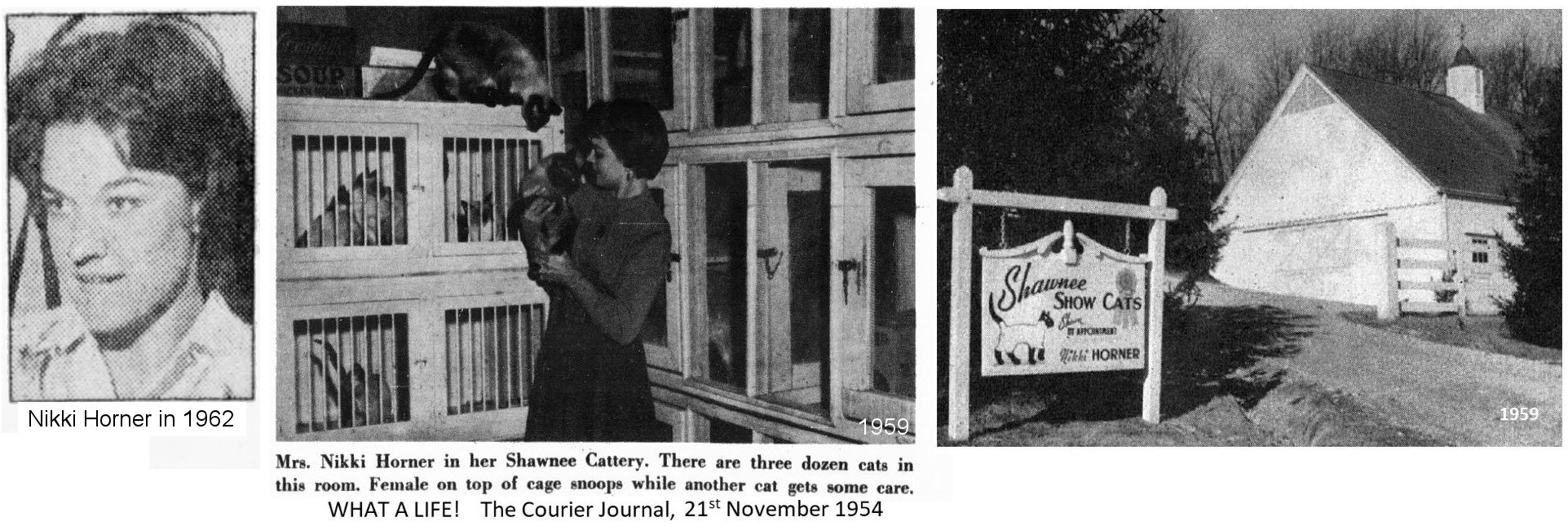
In 1947, one of her Siamese cats took the 1947 All-American award for Best Seal Point Siamese male! She continued to breed prize-winning Siamese until about 1957. She began breeding cats almost by accident. In a 1954 newspaper article it was explained that, although she was always interested in cats, Mrs. Horner turned to breeding in a sort of desperation. Dr. John W. Taylor, former president of the University of Louisville, brought her a pet Siamese female which he had obtained from a baroness in England. When the cat's calling time came [females call repeatedly when in heat, and Siamese can be particularly vocal] she “had to do something about it” otherwise she would not have had any sleep. (WHAT A LIFE! The Courier Journal, 21st November 1954).
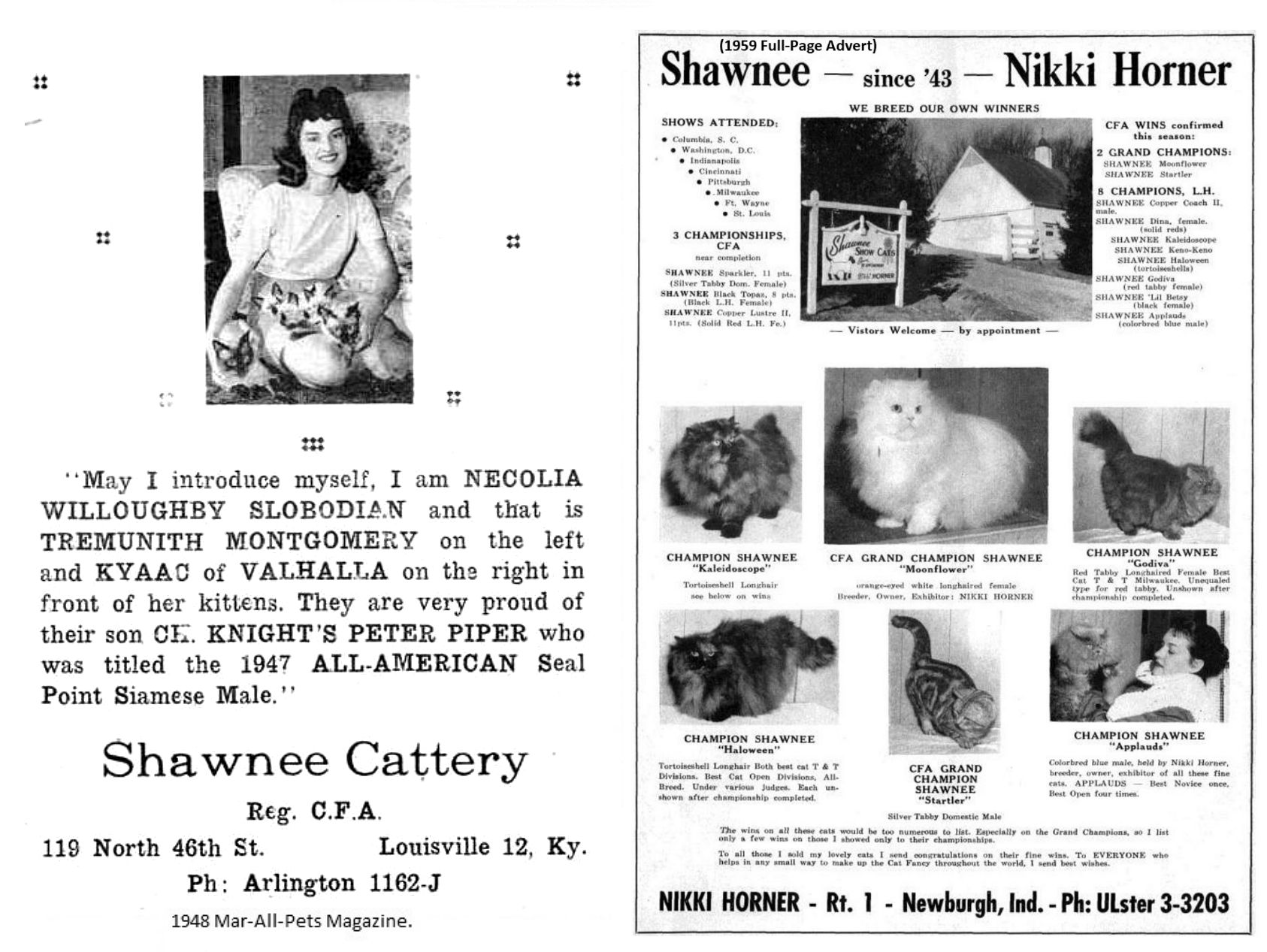
When Jean Sugden (later Jean Mill of “Bengal” cat fame) wanted to develop her own line of Himalayans in the late 1940s she sought breeding stock from breeders who had both Persians and Siamese and who might have had an accidental breeding between these. Only one breeder responded; a breeder who had two white shorthair females out of a Persian/Siamese cross. These were sent on a 72 hour rail journey to Jean Sugden. Although the breeder’s name wasn’t disclosed, the rail line went through Louisville, Kentucky, where Nikki Horner’s Shawnee cattery was based. Horner bred a large (by modern standards excessively large) number of cats and it has been hypothesised that the white shorthair Persian/Siamese crosses came from Shawnee cattery. (From private correspondence)
Horner was helping to organize cat clubs and shows in Kentucky as early as 1948, when she was elected President of the newly formed Kentucky Cat Club. She helped advertise the new club on a local radio station. In 1949 she moved from Kentucky to Pittsburgh, Pennsylvania and started to breed Persians. She divorced Alex Slobodian in 1951 and later that year she married Scoville Stephen Horner of Evansville, Indiana, a medical student, who eventually became a pharmaceutical representative.
She started modelling for Saks Fifth Avenue and capitalized on that notoriety in publicity for the shows she entered. As the Knoxville News Sentinel referred to her as “the beauteous Saks Fifth Avenue model Nikki Horner.” In 1954 she was a last-minute entrant in the 1954 Miss Kentucky contest – and won. She had started to work as a model to earn money to support her cats.
By the mid-1950s, her Shawnee cattery began working with the American Burmese breed. She also bred American Shorthairs, which were then known as Domestic Shorthairs. By 1959, “Shawnee” had become a household name to cat fanciers, and she had a large sign outside her home welcoming people to Shawnee Cattery. She became well-known for entering many cats at shows, the cages having yellow curtains and her cattery staff wearing yellow smocks (US shows were ring shows so cages were allowed to be decorated, unlike British GCCF shows where cages must be plain white).
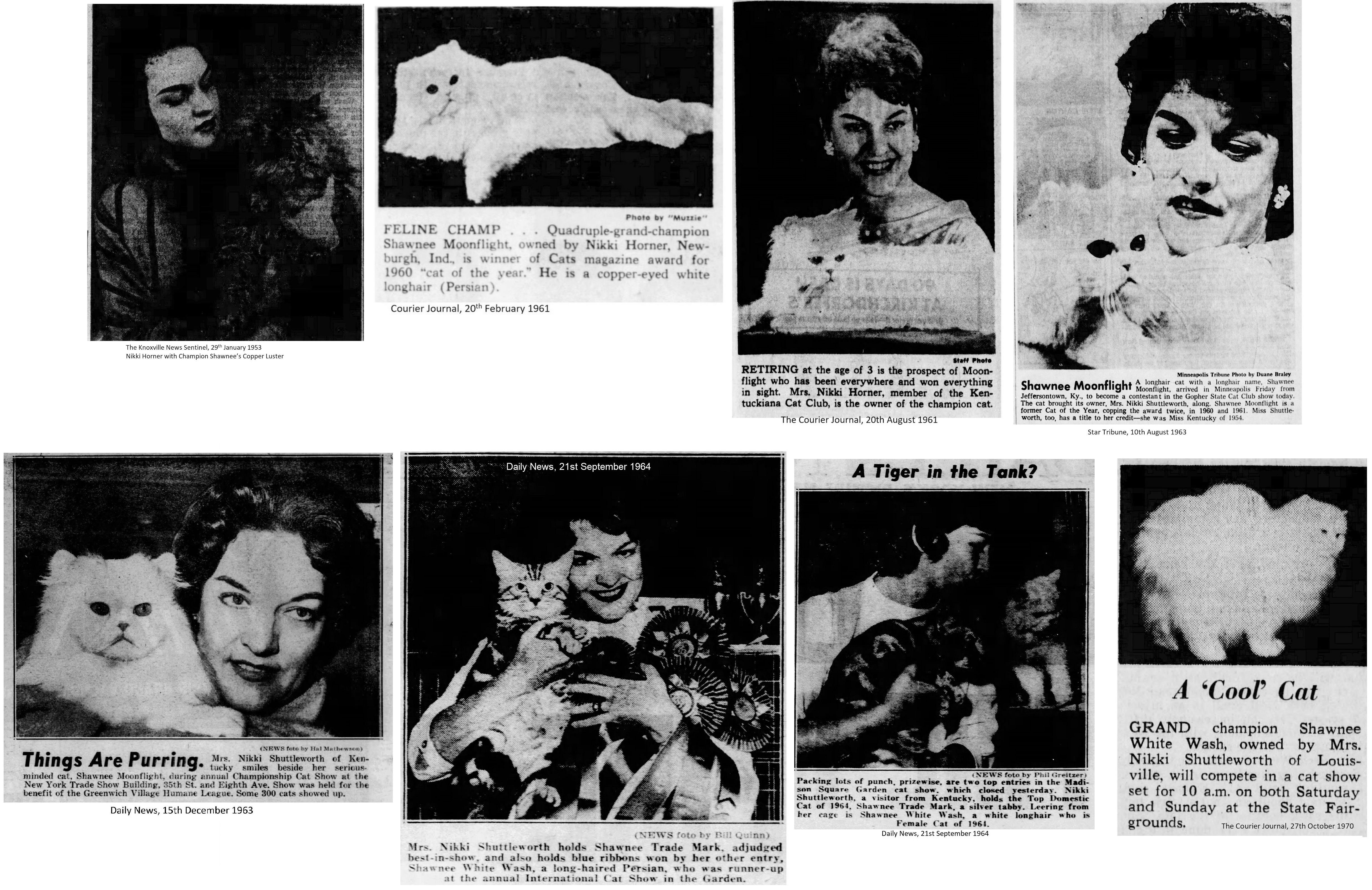
One of her most famous and successful white Persians was Shawnee Moonflight who is described in the following newscutting.
TOP CAT MAY RETIRE TO SHOW OFF KITTENS. The Courier Journal, 20th August 1961
You've heard of top dog - Well, the top dog in the cat-show world is thinking about retiring when this year’s round of shows is over. Moonflight may settle down and raise families. That’s the future being planned for him by his owner, Mrs. Nikki Horner, formerly of Louisville, now living in Newburgh, Ind. Mrs. Horner still is a member of the Kentuckiana Cat Club and will show Moonflight at the club’s show September 9 and 10 at the Fairground’s stadium.
The 3-year-old cat's record is as overwhelming as is his exquisite, snow-white, fairy-tale appearance. He has chalked up 63 “best-in-show” awards. For the past two years he has been named “cat of the year,” which means he is the top show cat in this country and Canada. He has some 1,500 rosettes for various recognitions; he has won 20 silver trays and six silver tea sets. His record of wins is three times that of any other cat shown in the country, according to his owner.
His complete name is Quadruple Grand Champion Shawnee Moonflight. He weighs 12 pounds, has orange eyes, and is long-haired. Long-haired - for those not hep to cat nomenclature - means the animal is a mixture of Angora and Persian. Moonflight’s attitude swings from a colossal indifference to overpowering affection. He often surprises strangers he takes a fancy to when he leaps onto their shoulders and snuggles and purrs.
The cat “has a regular natural diet like people should have,” his mistress said. She grinds up his meat and vegetables and tosses in some vitamins. “He eats better than I do - and doesn’t drink or smoke,” she added. Moonflight’s drink is distilled water. _ Also his face is washed with distilled water after every meal, then it is powdered. Moonflight is a messy eater, Mrs. Horner said. His toys, all of white yarn, are made to order by a Minneapolis firm. Every precaution is taken to prevent dirt or dyes from staining his delicate fur and skin.
Mrs. Horner, in Louisville yesterday on show business, has 39 other cats at home. These include Moonflight’s sister, who has won an impressive list of awards, and his brother, who is tarrying on the family line. So far Moonflight has shown no interest in other cats, Mrs. Horner regretted. Once he is away from the show circuit, the crowds, the acclaim, and the limelight of news and television cameras, he may settle down to domesticity - Mrs. Horner hopes.
In February of 1961, Horner appeared on the television show “To Tell the Truth.” The show challenged contestants to work out which of three people was telling the truth about an event or profession.
NEWBURGH, IND., CAT BREEDER STUMPS PANEL. Courier Journal, 20th February 1961: Nikki Horner, Newburgh, Ind., cat breeder, stumped the panel of “To Tell The Truth” on the segment to be seen on CBS, Monday at 6:30. The show will not be seen here, at least not today, as its spot is pre-empted by the Indiana-Ohio State basketball game. The program was taped last week. Miss Horner was in New York, showing her grand-champion white cat, Moonflight. The cat also appears on the program. None of the panellists voted for Miss Horner during the questioning which was designed to discover which of three people was “the real Nikki Horner.”
As a breeder of both Siamese and Persians, it was not surprising that she turned her hand to Himalayans in the early 1970s (though she may have bred some Siamese x Persian litters as early as the 1940s). Her Himalayans, though slightly less successful than her Persians, won numerous prizes. Horner had a good eye for which cats to mate together to produce the best offspring.
When Jean Sugden (later Jean Mill of “Bengal” cat fame) wanted to develop her own line of Himalayans in the late 1940s she sought breeding stock from breeders who had both Persians and Siamese and who might have had an accidental breeding between these. Only one breeder responded; a breeder who had two white shorthair females out of a Persian/Siamese cross. These were sent on a 72 hour rail journey to Jean Sugden. Although the breeder’s name wasn’t disclosed, the rail line went through Louisville, Kentucky, where Nikki Horner’s Shawnee cattery was based. Horner bred a large (by modern standards excessively large) number of cats and it has been hypothesised that the white shorthair Persian/Siamese crosses came from Shawnee cattery. (From private correspondence)
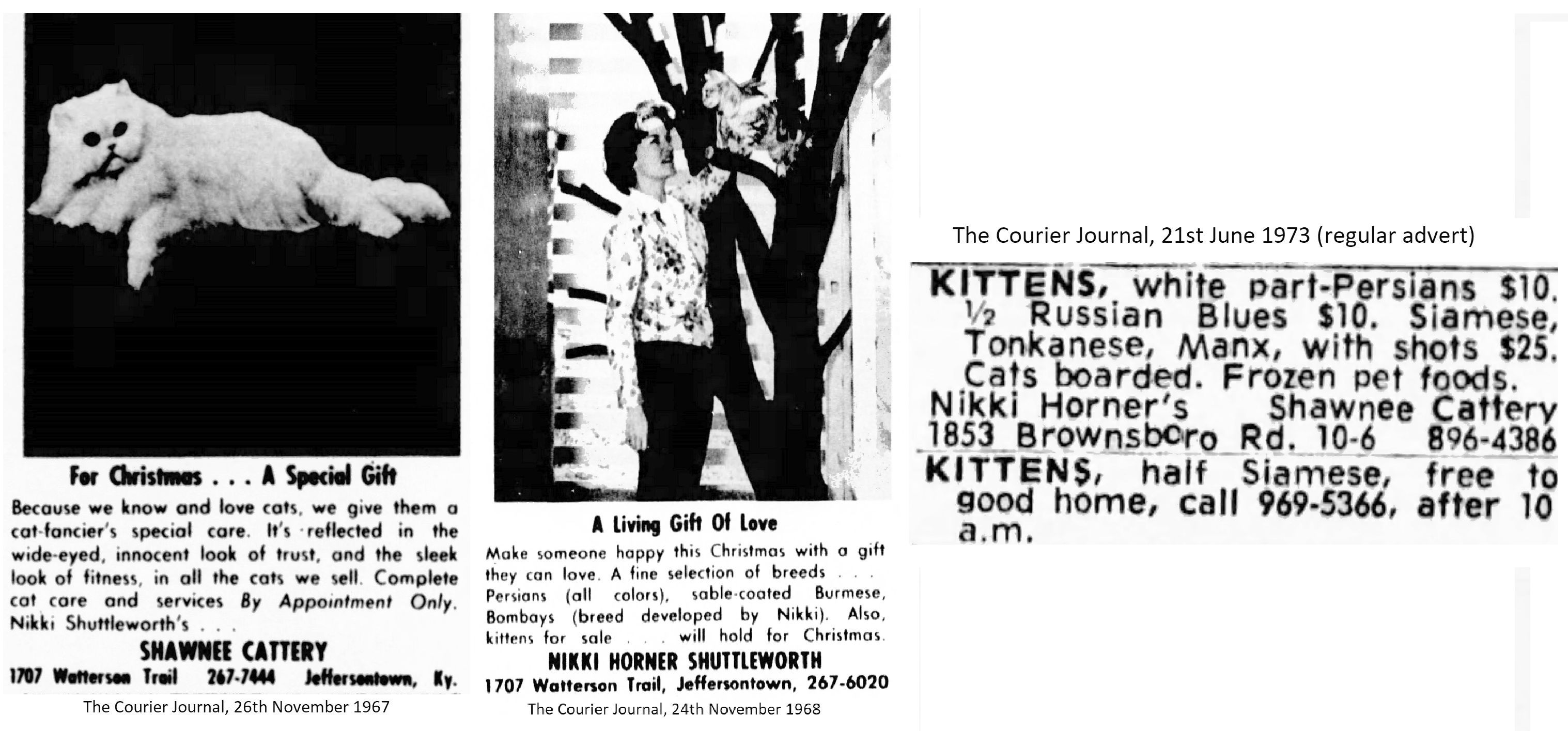
Nikki Horner (Mrs William Shuttleworth) began her American Shorthair programme with the purchase of silver tabby male "Shawnee Startler." Elsewhere it is claimed that she acquired "Katnip Korner Romeo" and renamed him "Shawnee Startler," but the pedigrees show these two cats have different birthdates and different parents. Katnip Korner Romeo (born 20 Jun 1947) is listed as a Chinchilla Persian son of Babe Le Roy of Beverly-Serrano (sire) and Duchess Doreen (dam), both Chinchilla Persians, but Shawnee Startler (born 16 June 1954) is listed as Domestic Shorthair (i.e. American Shorthair) son of Kute Silver of Katnip Korner (sire) and Katnip Korner Snicklefritz (dam). Photos show that Shawnee Startler was a silver tabby shorthair. Results published in the Akron Beacon Journal, 23rd January 1949 states that Katnip Korner Romeo was a shaded silver male.
Nikki Horner searched the country for mates for Shawnee Startler and chose the best female silver tabbies from the best pedigrees she could find. She later ventured into solid blacks, using a black female who popped up in one of her silver tabby litters, mating her with GC Karabee Dark Nite, founding the Shawnee blacks (she later founded the Bombay breed using her black American Shorthairs). Nikki Horner’s cats won major titles, much to the surprise of those who still viewed them as household tabbies, and American Shorthair catteries proliferated when people realized that the breed had real show potential.
By 1959, while living in Newburg, Indiana, Nikki bred a stunning silver tabby male, named Shawnee Marksman whose sire’s side traced back to well-known silver tabbies (Ramayana Jenna of Gray Horse Farm, Lavender Silver Stripes and Lavender Silver Goblin) but whose dam traced to unregistered pure silver tabby shorthair Kentucky farm cats. Once again, she was bred prizewinners. One of his sons, Shawnee Trademark (dam: Wolfgang La Rosa) is recognized as one of the greatest American Shorthairs of all time.
In 1961 she divorced Stephen Horner and by 1962 she was married to Dr. William Wallace Shuttleworth Jr. That year marked a hiatus in her string of top-flight prizewinners until Shawnee Trademark was born and swept all before him. As well as her silver tabbies she bred blaxk self American Shorthairs. In 1960 Shawnee Marksman x Shawnee Matilda produced an exceptional female named Shawnee Black Bon Bon who became the foundation female of her breeding line of Black American Shorthairs. Horner mated full-brother to full-sister for several generations. One of Bon Bon’s male offspring was Shawnee Anthracite. Another breeder, Kenneth David (Lexington, Kentucky) mated his black and white female, Pampas After Six, to Anthracite and this outcross improved the coat texture of the breed. One of the offspring was David’s Black Onyx who was mated to Shawnee Shot in the Dark, a daughter of Anthracite and her full-brother Obsidian. This produced David Copperfield of Shawnee. Horner kept David Copperfield in lieu of a stud fee. She also obtained Esquire Escapade of Shawnee (David’s Black Onyx x Shawnee Shot in the Dark) whom she mated to David Copperfield. The last litter of Shawnee American Shorthairs was registered in 1975 and I have not been able to trace descendants of this mating.
Little is known about the background of Horner’s extensive and very successful Burmese breeding programme. She crossed Burmese to black American Shorthairs as early as the mid-1950s, although her account of the first crossings are inconsistent. In 1953 she had bred a non-pedigreed black Domestic Shorthair to a Sable (i.e. Brown) Burmese. The kittens developed thick coats and looked like poor-quality American Shorthairs. Eventually she mated a female black American Shorthair, Shawnee Obsidian to Brown Burmese male Shawnee Cassius Clay and produced black Burmese-type kittens.
In 1958 the first Bombay-type cats appeared as an attempt to create a mini-black-panther using Burmese and American Shorthairs, but the results were apparently unsatisfactory and she didn’t develop the breed further at that that point.
In the mid-1960s, Horner made another attempt using her Brown Burmese male Shawnee Cassius Clay, his son Shawnee Little Brown Jug and grandson Shawnee Colonel Casey. The black American Shorthair males were David Copperfield of Shawnee and Shawnee Shot in the Dark. Their ancestors and some of the descendants are show in the family tree on this page. Some of the early Bombays were given away to people who would exhibit them and promote the new breed before it qualified for championship competition.
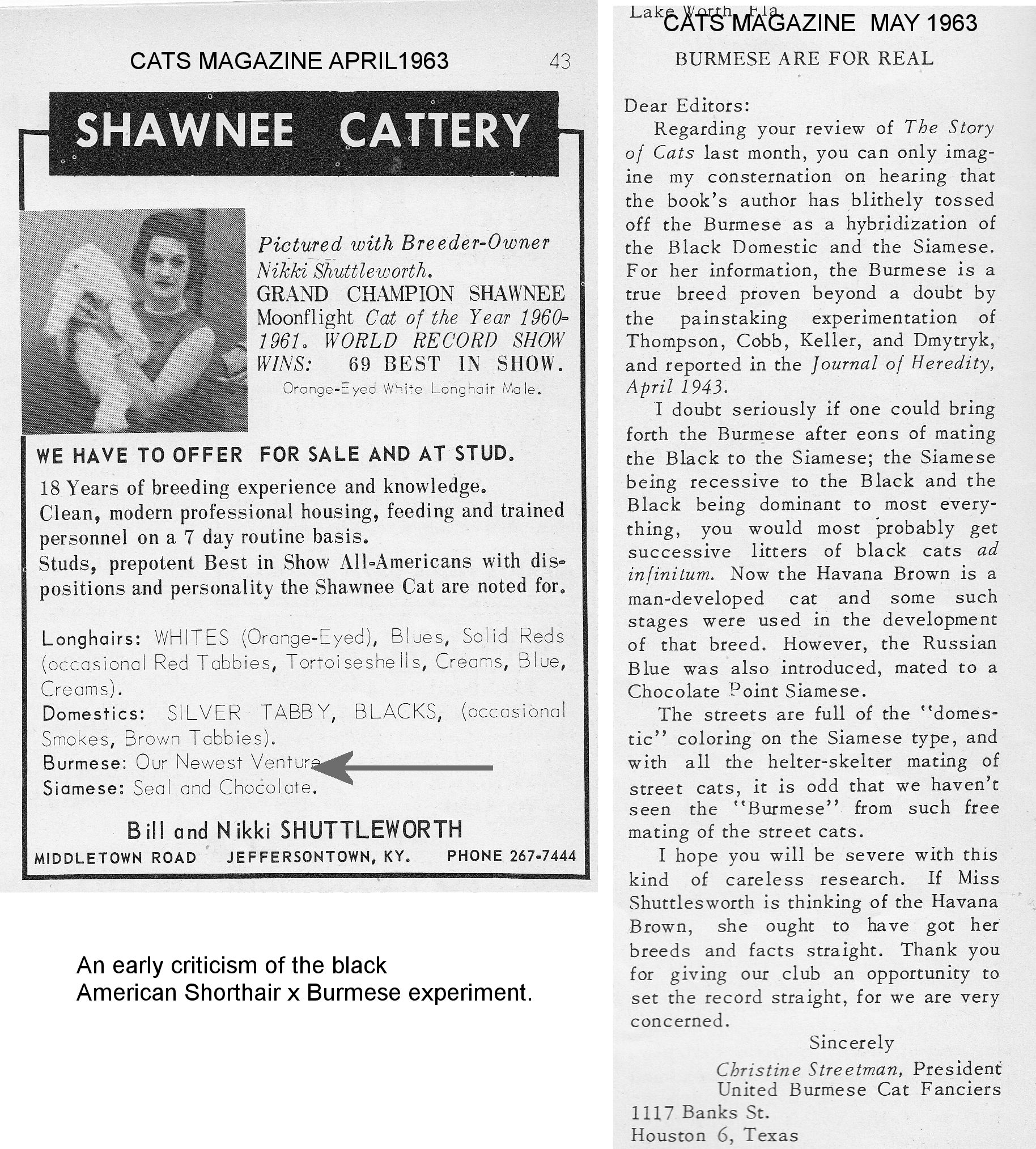
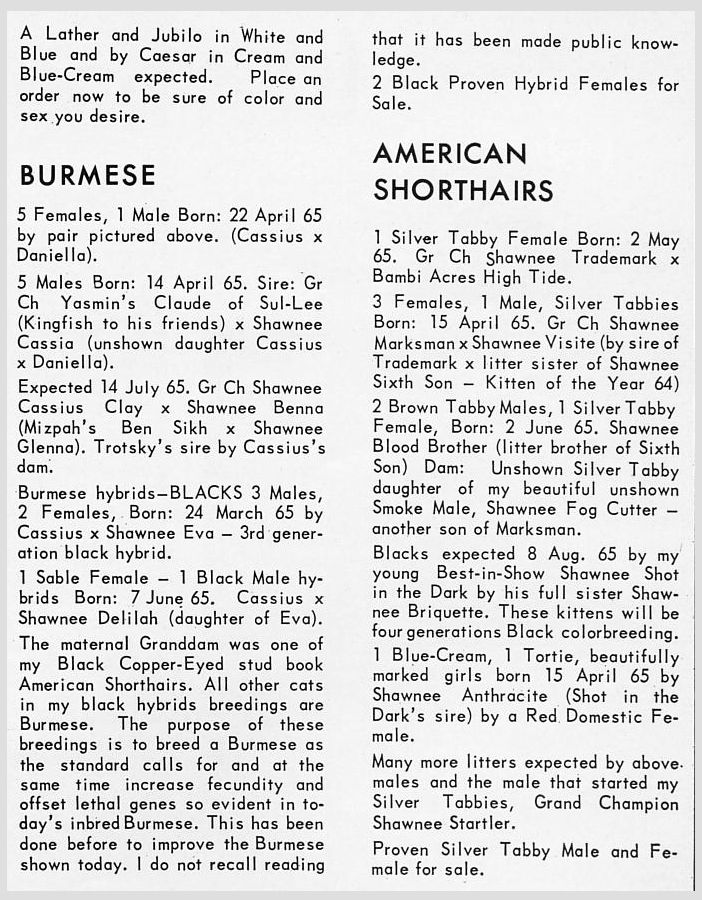
We find the background of the Bombay in the August 1965 issue of Cats Magazine. The double page spread gave the real reason that a Black Domestic was crossed to the American Burmese and it was not to create a “fireside panther” – it was to counter inbreeding depression in the American Burmese. What is interesting is the almost throwaway comment that the cross had been done before, but had not been made public knowledge. There had indeed been an accidental mating between a Black American Shorthair and an American Burmese. As well as expanding the Burmese gene pool, the black Burmese hybrids were attractive and marketable in their own right as “miniature black panthers.”
”BURMESE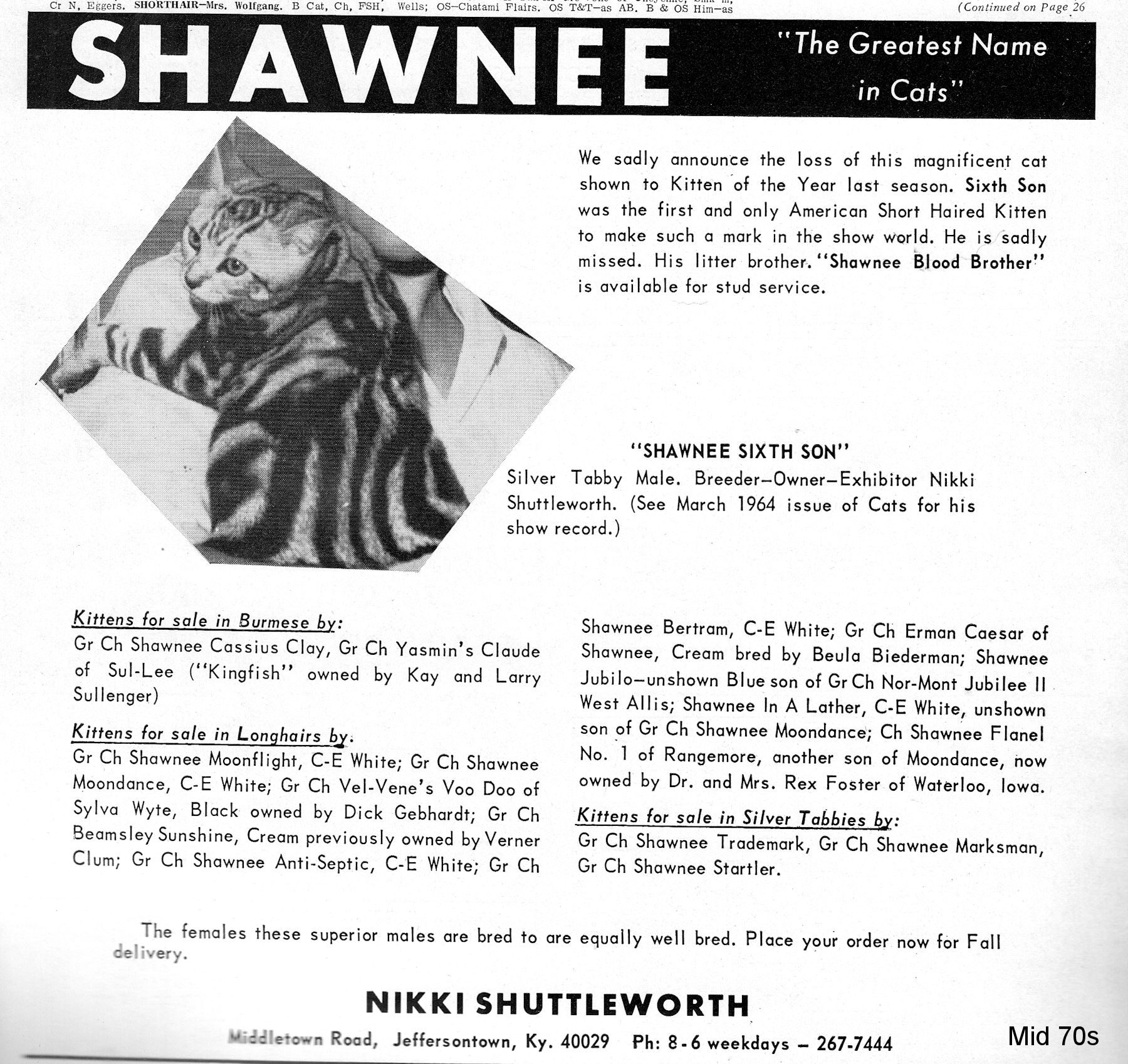
In 1970 the CFA recognised the Bombay and in 1976 it advanced to Championship status in 1976. That year, Horner retired from breeding and showing, and dispersed her cattery, but this was to be a temporary break.
She resumed showing, with Bombays, in the late 1980s, but by then Shawnee Cattery was co-owned by cattery manager Judy Scruggs who may have been doing the actual breeding. Horner herself was in failing health and died in April 1995. The larger size and muscular build of some modern American Bombays comes from Horner’s 4th generation "experiments" that started with an unusually large silver-furred, Sable [Brown] Burmese female between 1983 - 86.
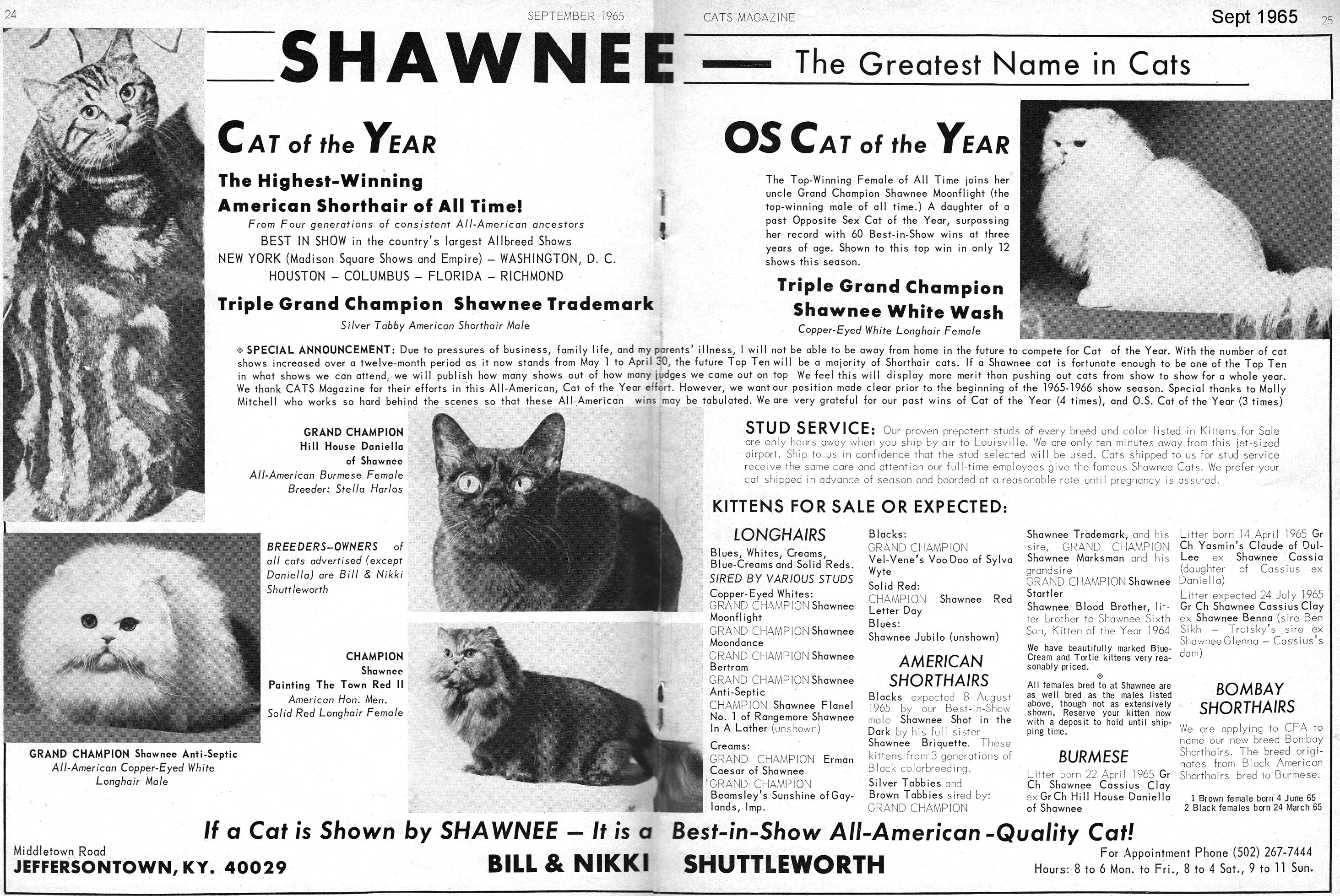
“NIKKI” HORNER DIES; WAS MISS KENTUCKY, TOP CAT BREEDER. 12th April 1995
Necolia W. ‘‘Nikki’’ Horner, an internationally known cat breeder and former Miss Kentucky, died of cancer yesterday at her home. Horner, who started raising cats when she was 16, developed the Bombay breed, which was introduced at the annual meeting of the Cat Fanciers Association in Toronto in 1970. Hers was the first domestic short-haired cat to be named “Cat of the Year.”
Horner had operated the Shawnee Cattery, which was well-known in the world of cats, and her entries had won numerous grand champion titles and were named best of show in hundreds of national and international cat shows. Horner was a member of the Cat Fanciers Association and had been manager of local shows sponsored by the Greater Louisville Cat Breeders Inc.
She was the former Necolia Willoughby and was named Miss Kentucky in 1954 after she entered the contest on the spur of the moment. Survivors include a brother, Thurston Willoughby of Bowling Green; and a friend, Judy Scruggs, who cared for her. The funeral will be at 1 p.m. to-morrow at Ratterman’s, 3711 Lexington Road, with burial in Cave Hill Cemetery. Visitation will be at the funeral home from 3 to 5 p.m. and 7 to 9 p.m. today. Memorial gifts can be made to the Humane Society.
NIKKI HORNER VS JEFFERSON COUNTY LAWSUIT
In the early 1970s, Horner filed a lawsuit against Jefferson County, Kentucky, requiring all cats over 6 months old to be licensed and to wear licence tags.
SUIT CHALLENGES CAT LICENSING BY THE COUNTY. The Courier Journal, 26th June 1971
A suit has been filed in Jefferson Circuit Court seeking to keep county officials from carrying out Jefferson Fiscal Court's cat licensing resolution. The court action seeks to nullify an April 27 Fiscal Court resolution that would require all cats in the county over six months old to be licensed, tagged and vaccinated against rabies effective July 1. A Louisville cat breeder, Nikki Horner, filed the suit "as a class action for herself and for all other cat owners in Jefferson County."
The case has been assigned to Jefferson Circuit Judge Macauley Smith and will receive a preliminary hearing on Wednesday. The suit contends that the Fiscal Court resolution lacks legislative authority and that the county dog warden has no jurisdiction over cats. It maintains that enforcement of the resolution would throw the county "into an uproar, with police officers in the county and city abandoning their chase of bank robbers and purse snatchers to pursue cats on foot, in helicopter and in high speed police cars, with their guns drawn and Mace in hand to capture the thousands of unlicensed cats at large."
Named as defendants in the suit are County Judge Todd Hollenbach; Jefferson County Commissioners Maurice Archer, Thomas Helm, and William H. Walden: and John R. Bennett, Jefferson County dog warden.
FISCAL COURT UNCOLLARS ITS RESOLUTION ON CATS. The Courier Journal, 30th June 1971
Jefferson County Atty. J. Bruce Miller yesterday moved to get cat lovers off his neck by taking collars off their cats. On Miller's recommendation, Fiscal Court revised an April 27 resolution requiring cats more than 6 months old to have licenses and a rabies shot by July 1. The cats still have to have both, but now they won't have to wear the license tags around their necks. The revision was made, County Judge Todd Hollenbach explained, because the collars could be dangerous to some breeds of cats.
County officials contend the licensing and rabies shots are necessary because of the danger of rabid cats, a danger the officials say is as great as that from rabid dogs. But many cat owners are unhappy with the licensing law, and one of them, Nikki Horner, has filed suit in Jefferson Circuit Court to keep county government from carrying out the resolution. The suit contends that the Fiscal Court resolution lacks legislative authority and that the county dog warden has no jurisdiction over cats.
COURT ALLOWS CAT LICENSING TO BEGIN TODAY. The Courier Journal, 1st July 1971
Court action yesterday left the Jefferson County cat licensing regulation standing for the time being. But Mrs. Nikki Horner, the cat owner who filed suit to nullify the regulation, won't have to obey it while the litigation continues, officials said. Jefferson County Fiscal Court voted April 27 to require licensing, tags and rabies vaccinations for cats. Later the county government retracted the requirement that the cats be tagged. Mrs. Horner's suit seeks to stop enforcement of the regulation, which takes effect today for cats six months old and older.
Jefferson Circuit Judge Macauley Smith originally had been scheduled to hear Mrs. Horner's suit. But he disqualified himself because she is the ex-wife of Smith's neighbor and veterinarian. Judge Marvin Sternberg, who took over the case, refused to sign an order yesterday that would restrain the county from enforcing the cat regulation. But he did so with the understanding the rule would not be enforced against Mrs. Horner and her cats while the suit is in court, County Atty. Bruce Miller said.
Miller said the cat regulation will still be in effect for the rest of the county's cat owners. He said a final determination on the merits of the case against the regulation probably would come in late summer or early fall.
Mrs. Horner, a spokeswoman for Cat Action Team (CAT), is a breeder of cats and manager of the annual Greater Louisville Cat Show. She operates Shawnee Cattery, 1853 Brownsboro Rd. Other CAT members will not be excused from the cat regulation provisions, Miller said. The cat lovers' organization was created to encourage better understanding and legal treatment for cats and their owners according to Mrs. Horner.
CAT-LICENSE SELLERS BUSY; FEW COMPLAIN. The Courier Journal, 2nd July 1971
Any businessman would like to have the kind of day that Jefferson County Dog Warden John Bennett had yesterday: hundreds of customers and mail orders and practically no complaints. Bennett's "customers" were cat owners–nearly 400 of them–who brought their pets to be vaccinated and licensed to comply with a fiscal court resolution that went into effect yesterday. He said the Animal Shelter on Manslick Road received "1,100 or 1,200 pieces of mail" requesting cat licenses. The Animal Shelter ordered 2,000 licenses in preparation for the enactment of the resolution and sold all but about 200 of the licenses yesterday, Bennett said.
The licenses cost $1.50 each and are issued only to owners of cats that have been vaccinated against rabies. The rabies shots, which are given at the clinic, cost $4 each for the initial vaccination, which protects the animal for a year. Annual booster shots also cost $4 each, Bennett said. Bennett said his office received only two "complaints" of unlicensed, unvaccinated cats yesterday. They came from "people calling about neighbors having a lot of cats," he said. The complaints are to be investigated today. Cat owners who don't comply with the new regulation will be cited, Bennett said.
Few of the cat owners who visited the clinic yesterday complained about having to vaccinate and license their pets, Bennett said. He added that the most frequently asked question was "Will I get my money back if the law is changed?"
The resolution originally called for cats over 6 months old to be licensed, vaccinated and identified with collar tags, but the collar rule later was rescinded after several cat owners protested. They claimed their pets could easily hang themselves by wearing collars.
Mrs. Nikki Horner, a breeder of cats and manager of the Greater Louisville Cat Show, has filed suit in Jefferson Circuit Court in an attempt to nullify the regulation. She has been exempted from the rule while the litigation continues, but Circuit Judge Marvin Sternberg refused to issue an order to restrain the county from enforcing the regulation against other cat owners.
‘10TH LIFE' WON BY CATS IN JEFFERSON. Lexington Leader, 1st April 1972
Cats in Jefferson County were given their tenth life Friday. Jefferson Circuit Court Judge Marvin J. Sternberg ruled that a cat resolution last July 1, which would have set up a vaccination and licensing procedure, was illegal. Sternberg said "the legislature has not conferred the authority on the Fiscal Court to require the vaccination of cats against rabies, nor are there any statutes from which this authority may be inferred." The suit was filed by Nikki Horner, a Louisville cat breeder, "as a class action for herself and for all other cat owners in Jefferson County."
Mrs. Nikki Horner, owner of the Shawnee Cattery. Prospect Ky., advocates giving endoritis [enteritis] serum to kittens when 6 to 12 weeks old, and after the twelfth week, two shots of vaccine a week apart. This, she says, gives them life-time immunity. Another disease common to males is uremic poisoning. Mrs. Horner's long-hair Champion Shawnee Copper Coach was a victim of this ailment. She recommends as a preventive fresh water, exercise, and 25,000 units of vitamin A every day.